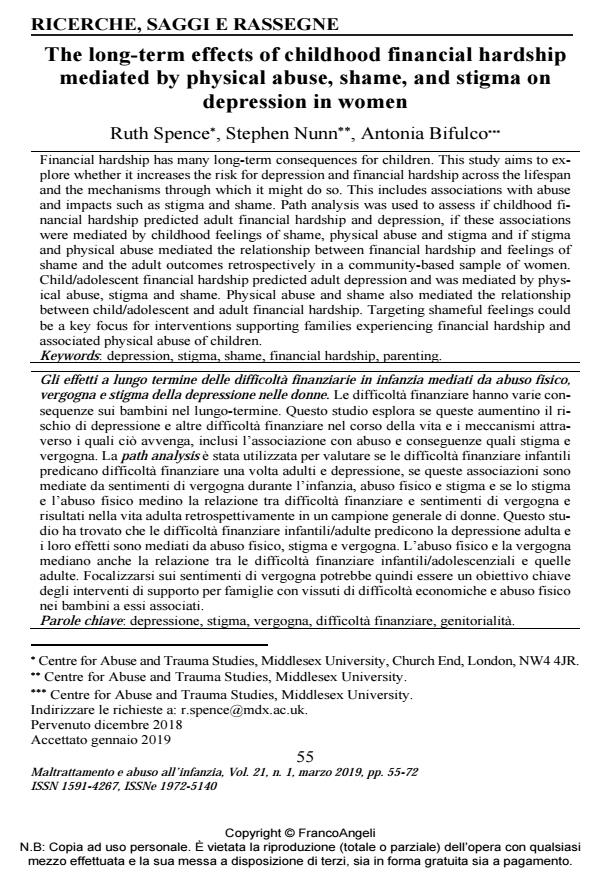The long-term effects of childhood financial hardship mediated by physical abuse, shame, and stigma on depression in women
Titolo Rivista MALTRATTAMENTO E ABUSO ALL’INFANZIA
Autori/Curatori Ruth Spence, Stephen Nunn, Antonia Bifulco
Anno di pubblicazione 2019 Fascicolo 2019/1
Lingua Inglese Numero pagine 18 P. 55-72 Dimensione file 241 KB
DOI 10.3280/MAL2019-001005
Il DOI è il codice a barre della proprietà intellettuale: per saperne di più
clicca qui
Qui sotto puoi vedere in anteprima la prima pagina di questo articolo.
Se questo articolo ti interessa, lo puoi acquistare (e scaricare in formato pdf) seguendo le facili indicazioni per acquistare il download credit. Acquista Download Credits per scaricare questo Articolo in formato PDF

FrancoAngeli è membro della Publishers International Linking Association, Inc (PILA)associazione indipendente e non profit per facilitare (attraverso i servizi tecnologici implementati da CrossRef.org) l’accesso degli studiosi ai contenuti digitali nelle pubblicazioni professionali e scientifiche
Financial hardship has many long-term consequences for children. This study aims to explore whether it increases the risk for depression and financial hardship across the lifespan and the mechanisms through which it might do so. This includes associations with abuse and impacts such as stigma and shame. Path analysis was used to assess if childhood financial hardship predicted adult financial hardship and depression, if these associations were mediated by childhood feelings of shame, physical abuse and stigma and if stigma and physical abuse mediated the relationship between financial hardship and feelings of shame and the adult outcomes retrospectively in a community-based sample of women. Child/adolescent financial hardship predicted adult depression and was mediated by physical abuse, stigma and shame. Physical abuse and shame also mediated the relationship between child/adolescent and adult financial hardship. Targeting shameful feelings could be a key focus for interventions supporting families experiencing financial hardship and associated physical abuse of children.
Le difficoltà finanziare hanno varie consequenze sui bambini nel lungo-termine. Questo studio esplora se queste aumentino il rischio di depressione e altre difficoltà finanziare nel corso della vita e i meccanismi attraverso i quali ciò avvenga, inclusi l’associazione con abuso e conseguenze quali stigma e vergogna. La path analysis è stata utilizzata per valutare se le difficoltà finanziare infantili predicano difficoltà finanziare una volta adulti e depres-sione, se queste associazioni sono mediate da sentimenti di vergogna durante l’infanzia, abuso fisico e stigma e se lo stigma e l’abuso fisico medino la relazione tra difficoltà finan-ziare e sentimenti di vergogna e risultati nella vita adulta retrospettivamente in un campione generale di donne. Questo studio ha trovato che le difficoltà finanziare infantili/adulte predi-cono la depressione adulta e i loro effetti sono mediati da abuso fisico, stigma e vergogna. L’abuso fisico e la vergogna mediano anche la relazione tra le difficoltà finanziare infanti-li/adolescenziali e quelle adulte. Focalizzarsi sui sentimenti di vergogna potrebbe quindi es-sere un obiettivo chiave degli interventi di supporto per famiglie con vissuti di difficoltà economiche e abuso fisico nei bambini a essi associati.
Parole chiave:Depressione, stigma, vergogna, difficoltà finanziare, genitorialità
- Exploring trauma and attachment style over the lifespan using secondary data: A single case study of two sisters Deborah Bailey-Rodriguez, Nollaig Frost, in MALTRATTAMENTO E ABUSO ALL'INFANZIA 2/2019 pp.45
DOI: 10.3280/MAL2019-002004 - Impacts of childhood maltreatment in adulthood Antonia Bifulco, Nollaig Frost, in MALTRATTAMENTO E ABUSO ALL'INFANZIA 2/2019 pp.7
DOI: 10.3280/MAL2019-002001 - Historical child abuse and intergenerational transmission: Experiences of midlife women and their older-age mothers Antonia Bifulco, Catherine Jacobs, Elena Carraro, in MALTRATTAMENTO E ABUSO ALL'INFANZIA 3/2019 pp.23
DOI: 10.3280/MAL2019-003003
Ruth Spence, Stephen Nunn, Antonia Bifulco, The long-term effects of childhood financial hardship mediated by physical abuse, shame, and stigma on depression in women in "MALTRATTAMENTO E ABUSO ALL’INFANZIA" 1/2019, pp 55-72, DOI: 10.3280/MAL2019-001005